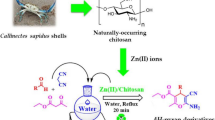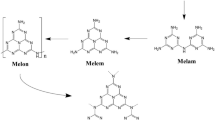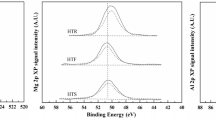Abstract
Citral is an oxygenated–monoterpenoid found as a major component in lemongrass essential oil (> 68%) in its isomeric forms of geranial (E−) and neral (Z−). For the value addition of this low-value essential oil, a novel catalytic process has been developed for transformation of citral to enantiospecific (+)-citronellal using 12% Ni–HT-530. The different amounts of Ni were doped through hydrothermal process and calcined at varying temperatures (490, 530, and 570 °C). The performance of composite prepared through hydrothermal process was compared with the wet impregnation method. The composite of hydrothermal process followed by calcination at 530 °C was highly potential for selective conversion of citral to (+)-citronellal. The effects of variables such as reaction time, temperature, hydrogen-pressure, and catalyst-dosage on citral conversion to (+)-citronellal were examined. The citral conversion (99%) was attained with 95% selectivity to citronellal in a ratio of catalyst to citral (1:6) under 110 psi H2 pressure at 90 °C for 90 min using 12% Ni–HT-530. Furthermore, the direct conversion of citral in lemongrass oil was studied at above optimized condition. The result indicated that the synthesized catalyst is equally effective in transforming citral in lemongrass oil to organoleptically superior (+)-citronellal with 93% selectivity. The selective conversion of citral to (+)-citronellal not only increases the fragrance value of the essential oil, but also increases the scope for various industrial applications like fine chemical synthesis and pharmaceutical applications.
Graphical Abstract








Similar content being viewed by others
References
Little LD (1914) A colorimetric method for the determination of citral in extracts of lemon and in oil of lemon. J Am Pharma Assoc (1912) 3(4):553–556
Silva CD, Guterres SS, Weisheimer V et al (2008) Antifungal activity of the lemongrass oil and citral against Candida spp. Braz J Infect Dis 12:63–66
Yu S, Chen X, Tong L et al (2007) Simultaneous determination of the 6-methyl-5-hepten-2-one, limonene, linalool and citral in essential oil from Litsea cubeba (Lour) pers by capillary gas chromatography. Asian J Tradit Med 2(2):66–69
Long N, Tang H, Sun F et al (2019) Effect and mechanism of citral against methicillin-resistant Staphylococcus aureus in vivo. J Sci Food Agri 99(9):4423–4429
Ganjewala D, Luthra R (2010) Essential oil biosynthesis and regulation in the genus cymbopogon. Nat Prod Commun 5(1):1934578X1000500137. https://doi.org/10.1177/1934578X1000500137
Ekou T, Flura A, Ekou L et al (2012) Selective hydrogenation of citral to unsaturated alcohols over mesoporous Pt/Ti–Al2O3 catalysts. Effect of the reduction temperature and of the Ge addition. J Mol Catal A 353:148–155
Zgolicz PD, Stassi JP, Yañez MJ et al (2012) Influence of the support and the preparation methods on the performance in citral hydrogenation of Pt-based catalysts supported on carbon nanotubes. J Catal 290:37–54
Stolle A, Gallert T, Schmöger C et al (2013) Hydrogenation of citral: a wide-spread model reaction for selective reduction of α, β-unsaturated aldehydes. RSC Adv 3(7):2112–2153
Huang Y, Qiu S, Xu J et al (2020) Hydrogenation of citral to citronellal catalyzed by waste fluid catalytic cracking catalyst supported nickel. ACS Omega 6(1):476–482
Syunbayev U, Churina DK, Yergaziyeva GY et al (2016) The liquid-phase hydrogenation of citral to citronellal at hydrogen pressure. Int J Chem Eng Appl 7(2):133–137
Salminen E, Virtanen P, Mikkola JP (2014) Alkaline ionic liquids applied in supported ionic liquid catalyst for selective hydrogenation of citral to citronellal. Front in Chem 2(3):1–5
Zhao Y, Zhang H, Huang C et al (2013) Pd nanoparticles immobilized on graphite oxide modified with a base: highly efficient catalysts for selective hydrogenation of citral. Sci China Chem 56(2):203–209
Daza CE, Moreno S, Molina R (2011) Co-precipitated Ni–Mg–Al catalysts containing Ce for CO2 reforming of methane. Int J Hydrog Energ 36(6):3886–3894
González AR, Asencios YJ, Assaf EM et al (2013) Dry reforming of methane on Ni–Mg–Al nano-spheroid oxide catalysts prepared by the sol-gel method from hydrotalcite-like precursors. Appl Surf Sci 280:876–887
Hou Z, Yashima T (2004) Meso-porous Ni/Mg/Al catalysts for methane reforming with CO2. Appl Catal A 261(2):205–209
Tsyganok AI, Tsunoda T, Hamakawa S et al (2003) Dry reforming of methane over catalysts derived from nickel-containing Mg–Al layered double hydroxides. J Catal 213(2):191–203
Cavani F, Trifiro F, Vaccari A (1991) Hydrotalcite-type anionic clays: preparation, properties and applications. Catal Today 11(2):173–301
Forano C, Costantino U, Pre´vot V, et al (eds) (2006) Handbook of clay science. Elsevier, Amsterdam, London
Adams RP (1995) Identification of essential oil components by gas chromatography/mass spectroscopy. Allured Publ. Corp, Carol Stream, IL
Chanotiya CS, Pragadheesh VS, Yadav A et al (2021) Cyclodextrin-based gas chromatography and GC/MS methods for determination of chiral pair constituents in mint essential oils. J Essent Oil Res 33(1):23–31
Rives V (2002) Characterisation of layered double hydroxides and their decomposition products. Mat Chem Phy 75(1–3):19–25
Sharma SK, Srivastava VK, Shukla RS et al (2007) One-pot synthesis of C8 aldehydes/alcohols from propylene using eco-friendly hydrotalcite supported HRhCO (PPh3)3 catalyst. New J Chem 31(2):277–286
Srivastava VK, Sharma SK, Shukla RS et al (2006) The ‘single-pot’synthesis of C2n+2-aldol derivatives from Cn-alkenes using multi-functional catalyst. Catal Commun 7(11):879–884
Li R, Hu Z, Shao X et al (2016) Large scale synthesis of NiCo layered double hydroxides for superior asymmetric electrochemical capacitor. Sci Reports 6(1):1–9
Pérez-Ramírez J, Mul G, Kapteijn F et al (2001) In situ investigation of the thermal decomposition of Co–Al hydrotalcite in different atmospheres. J Mat Chem 11(3):821–830
Ding Y, Xu L, Chen C et al (2008) Syntheses of nanostructures of cobalt hydrotalcite like compounds and Co3O4 via a microwave-assisted reflux method. J Phy Chem C 112(22):8177–8183
Salmi T, Mäki-Arvela P, Toukoniitty E et al (2000) Liquid-phase hydrogenation of citral over an immobile silica fibre catalyst. Appl Catal A 196(1):93–102
Tiainen LP, Mäki-Arvela P, Neyestanaki AK et al (2003) Modelling of catalyst deactivation in liquid phase reactions: citral hydrogenation on Ru/Al2O3. React Kinet Catal Lett 78(2):251–257
Mäki-Arvela P, Kumar N, Eränen K et al (2006) Inverse temperature dependence due to catalyst deactivation in liquid phase citral hydrogenation over Pt/Al2O3. Chem Eng J 122(3):127–134
Kumar P, Chanotiya CS, Bawitlung L et al (2022) Exploitation of liquid CO2 based greener process for valorization of citronellal-rich essential oils into flavor grade (-)-menthol using novel Sn/Al-B-NaYZE composites. Waste Biomass Valor. https://doi.org/10.1007/s12649-022-01984-7
Chiang SJ, Yang CH, Chen YZ et al (2007) High-active nickel catalyst of NiB/SiO2 for citral hydrogenation at low temperature. Appl Catal A 326(2):180–188
Chen YZ, Liaw BJ, Chiang SJ (2005) Selective hydrogenation of citral over amorphous NiB and CoB nano-catalysts. Appl Catal A 284(1–2):97–104
Tang Y, Yang D, Qin F et al (2009) Decorating multi-walled carbon nanotubes with nickel nanoparticles for selective hydrogenation of citral. J Solid State Chem 182(8):2279–2284
Antonels NC, Meijboom R (2014) Preparation of well-defined dendrimer encapsulated ruthenium nanoparticles and their application as catalyst and enhancement of activity when utilised as SCILL catalysts in the hydrogenation of citral. Catal Commun 57:148–152
Chatterjee M, Zhao FY, Ikushima Y (2004) Hydrogenation of citral using monometallic Pt and bimetallic Pt–Ru catalysts on a mesoporous support in supercritical carbon dioxide medium. Adv Syn Catal 346(4):459–466
Zhu J, Li M, Lu M et al (2013) Effect of structural properties on catalytic performance in citral selective hydrogenation over carbon–titania composite supported Pd catalyst. Catal Sci Technol 3(3):737–744
Acknowledgements
The authors are thankful to Science and Engineering Research Board (SERB), DST, India (CRG/2021/002525) for research funding. We are grateful to Director, CSIR-CIMAP, Lucknow for providing the necessary facility under Aroma Mission, Phase-II (HCP 0007, PE-II). Dr. S Chaturvedi is thankful to DST for WOS-A fellowship (DST/WOS-A/CS-94/2021).
Author information
Authors and Affiliations
Contributions
PK: methodology, validation, investigation, writing—original draft; PKS: methodology, writing—draft and investigation; SC: conceptualization, validation, reviewing; CSC: conceptualization, validation, visualization; PRR: methodology, validation; PM: methodology, validation, visualization; PKR: methodology, validation, investigation, funding acquisition, writing—review & editing
Corresponding authors
Ethics declarations
Conflict of interest
The authors declare that they have no conflict of interest.
Additional information
Publisher's Note
Springer Nature remains neutral with regard to jurisdictional claims in published maps and institutional affiliations.
Supplementary Information
Below is the link to the electronic supplementary material.
Rights and permissions
Springer Nature or its licensor (e.g. a society or other partner) holds exclusive rights to this article under a publishing agreement with the author(s) or other rightsholder(s); author self-archiving of the accepted manuscript version of this article is solely governed by the terms of such publishing agreement and applicable law.
About this article
Cite this article
Kumar, P., Sharma, P.K., Chaturvedi, S. et al. Synthesis of Ni-Doped Hydrotalcite Catalyst Through Hydrothermal Process for the Selective Reduction of α,β-Unsaturated Aldehyde (Citral) to Enantiospecific (+)-Citronellal. Catal Lett 153, 3019–3030 (2023). https://doi.org/10.1007/s10562-022-04195-w
Received:
Accepted:
Published:
Issue Date:
DOI: https://doi.org/10.1007/s10562-022-04195-w




